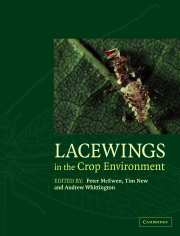Book contents
- Frontmatter
- Contents
- List of contributors
- Preface
- PART 1 Lacewing systematics and ecology
- PART 2 Lacewings in crops
- Introduction to Part 2
- CHAPTER 8 Lacewings in field crops
- CHAPTER 9 Lacewings in fruit and nut crops
- CHAPTER 10 Lacewings in vegetables, forests, and other crops
- PART 3 Principles
- PART 4 Case studies
- PART 5 Conclusion
- Taxonomic index
- General index
Introduction to Part 2
Published online by Cambridge University Press: 04 May 2010
- Frontmatter
- Contents
- List of contributors
- Preface
- PART 1 Lacewing systematics and ecology
- PART 2 Lacewings in crops
- Introduction to Part 2
- CHAPTER 8 Lacewings in field crops
- CHAPTER 9 Lacewings in fruit and nut crops
- CHAPTER 10 Lacewings in vegetables, forests, and other crops
- PART 3 Principles
- PART 4 Case studies
- PART 5 Conclusion
- Taxonomic index
- General index
Summary
The species of lacewings found in the crop environment may, in some way, be ‘pre-adapted’ to that environment through their regular association with a given vegetation type, and by prey preferences. In seeking additional candidate species for use in IPM, surveys of the lacewings found ‘naturally’ on particular crops or vegetation may provide valuable leads on which may be useful, and thus targeted for increasing the collective impact on pests or – at least – for augmenting control. Much of the use of lacewings in IPM will rely increasingly on native species, perhaps those found naturally in relatively limited areas or microhabitats, and the study of such natural assemblages will also suggest combinations of species for complementary use. This may involve combinations of high impact generalist species (such as members of the Chrysoperla carnea group, so beneficial in a great variety of crop situations) and more specialised species whose more restricted predilections may favour their use in particular contexts.
This section helps us to understand the spectrum of lacewings which may be involved, and how the assemblages found on different crops vary. Despite the generalised information available, the essays collectively mention around 10% each of the global fauna of Chrysopidae and Hemerobiidae (113 species in 22 genera, and 64 species in 10 genera respectively), but also indicate the low involvement of Coniopterygidae. A general picture emerges of particular lacewing species being abundant on different crops, and a greater variety of low abundance (and, perhaps, less habitatspecific or habitat-dependent) taxa.
- Type
- Chapter
- Information
- Lacewings in the Crop Environment , pp. 157Publisher: Cambridge University PressPrint publication year: 2001



